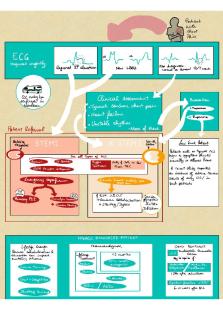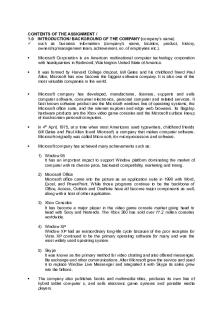Dominican Republic Infographic Notes PDF

| Title | Dominican Republic Infographic Notes |
|---|---|
| Author | Emma Edelweiss-Lawyer |
| Course | International Health |
| Institution | Brigham Young University |
| Pages | 4 |
| File Size | 127.5 KB |
| File Type | |
| Total Downloads | 26 |
| Total Views | 124 |
Summary
Notes for the info-graphic assignment...
Description
Dominican Republic Infographic Notes Education ● Enrollment rates improving! “Primary education net enrolment rates rose from 83% in 1999 to 89.1% in 2012, while secondary education net enrolment rates rose from 39% in 1999 to 62% in 2012. The completion rate for primary education also rose steadily, from 62% in 1994 to 73% in 2012.” ○ http://www.unesco.org/new/en/gefi/partnerships/gefi-championcountries/dominican-republic/ ○ “Dominican Republic: United Nations Educational, Scientific and Cultural Organization.” Dominican Republic | United Nations Educational, Scientific and Cultural Organization, 2015, www.unesco.org/new/en/gefi/partnerships/gefichampion-countries/dominican-republic/. “About 40 percent of students drop out of school before eighth grade. One in four girls drops out of school due to pregnancy. While the literacy rate of the Dominican Republic is about 92 percent, studies have found that students who complete high school enter university at a sixthgrade reading level.” https://borgenproject.org/education-in-the-dominican-republic/ Rates of out of school children http://uis.unesco.org/en/country/do Rate of children out of school is decreasing 2011- Overall: 56,059 Girls: 34,746 Boys: 21,313 2012- Overall: 70,495 Girls: 41,041 Boys: 29,454 2013- Overall: 73,041 Girls: 40,239 Boys: 32,802 2014- Overall: 93,781 Girls: 49,582 Boys: 44,199 2015- Overall: 52,389 Girls: 28,587 Boys: 23,802 2016- Overall: 53,438 Girls: 26,180 Boys: 27,258 2017- Overall: 61,774 Girls: 29, 807 Boys: 31,967 % of Children enrolled in primary education: secondary ed:
% of Adolescents enrolled in
Rate of children in both primary and secondary education is increasing. More boys enrol in primary education than girls, but more boys drop out and. Thus more girls enroll for secondary education than boys. 2011: Total: 91.89 Girls: 90.05 Boys: 93.66
Total: 63.18 Girls: 67.72 Boys: 58.74
2012: Total: 91.01 Girls: 89.32 Boys: 92.65
Total: 63.82 Girls: 68.32 Boys: 59.43
2013: Total: 90.85 Girls: 89.52 Boys: 92.12
Total: 65.56 Girls: 70.05 Boys: 61.17
2014: Total: 89.28 Girls: 88.14 Boys: 90.39
Total: 66.95 Girls: 71.37 Boys: 62.64
2015: Total: 93.53 Girls: 92.59 Boys: 94.43
Total: 67.83 Girls: 72.33 Boys: 63.44
2016: Total: 93.33 Girls: 92.98 Boys: 93.66
Total: 68.89 Girls: 73.23 Boys: 64.65
2017: Total: 92.87 Girls: 92.71 Boys: 93.03
Total: 70.27 Girls: 74.19 Boys: 66.45
Gender Rights ● Gender gap in education decreasing! “The Dominican Republic has been successful in lessening the gender gap and maintaining this throughout primary and secondary levels of schooling. The primary education completion rate in 2012 was 91.4% for females and 89.2% for males. In 2012, the ratio of females to males in primary education level was 89:100, while in secondary education, it reached 109:100.” ○ “Dominican Republic: United Nations Educational, Scientific and Cultural Organization.” Dominican Republic | United Nations Educational, Scientific and Cultural Organization, 2015, www.unesco.org/new/en/gefi/partnerships/gefichampion-countries/dominican-republic/. ● According to a survey, most women still value traditional gender roles but have a significant role in family-owned agricultural businesses. ● They make decisions jointly with their spouse. “The vast majority of these women identify their chief activity as caring for the house and family, despite their involvement in household agriculture and often other income-generating activities.” “...Most women report that they are involved, as primary (32%) or joint (50%) decision-makers, in most household decisions” ○ Raynolds, Laura T. “Wages for Wives: Renegotiating Gender and Production Relations in Contract Farming in the Dominican Republic.” World Development, vol. 30, no. 5, 2002, pp. 783–798., doi:10.1016/s0305-750x(02)00008-6. ○ https://www.sciencedirect.com/science/article/pii/S0305750X02000086 ● “literacy and primary education enrollment levels in the Dominican Republic are relatively high for both women and men” ● “Women are significantly underrepresented in the job market” ○ In 2000, 16.3 percent of women and 16.3 percent of men were reported to be illiterate in the Dominican Republic. Ninety-three percent of girls were enrolled in primary school that same year, compared to 92 percent of boys. See World Bank, “Gender Stats, Summary Country Profile, Dominican Republic” [online] http://devdata.worldbank.org/genderstats/genderRpt.asp? rpt=profile&cty=DOM,Dominican%20Republic&hm=home (needs citation still) ○ https://www.hrw.org/reports/2004/dr0704/3.htm ● “Older men often resent the newfound independence of the women working in these areas and stereotype them as “spendthrifts” who make money to buy extravagances for themselves, even though women insist they are working to support their children.... women in the
Dominican Republic make 44 percent less than men, and, in the workforce overall, just 50.5 percent of women participate, compared to 79.8 percent of men. [7] This illustrates the wide gender gap that leaves many women without economic agency and in the hands of men, which oftentimes comes with violent consequences.” http://www.coha.org/machismofemicide-and-sex-tourism-an-overview-of-womens-rights-in-the-dominican-republic/
Cultural Issues ● Various cultures are present in the DR. Mixing of culture may cause contention ○ “While Whiteness may be the cultural and physical standard for the Dominican, people of African descent have always been the majority in the Dominican Republic.” ○ Bankay, Anne Maria. “Contemporary Women Poets of the Dominican Republic: Perspectives on Race and Other Social Issues.” Afro-Hispanic Review , vol. 12, no. 1, 1993, pp. 34–41., https://www.jstor.org/stable/23053997. ○ https://www.jstor.org/stable/pdf/23053997.pdf ● Superstition, religion, and gender norms affect health and whether or not someone gets needed help. https://corescholar.libraries.wright.edu/cgi/viewcontent.cgi? article=1102&context=mph North, Christine L. "Improving Childhood Nutrition in Rural Dominican Republic." Master of Public
Health Program Student Publications, 2012, pp. 22-24.
○ “Dominicans often blame spiritual or superstitious causes for medical conditions (Person et al., 2006). Babington, Kelley, Patsdaughter, Soderberg, and Kelly (1999) also found that spiritual and mystical practices were highly influential in seven rural villages in the Northern Dominican Republic. As a result, individuals often sought care from curanderos (folk healers), ensalmadores (special herbalists) or brujos (witch doctors) (Schumacher, 2010)” ○ “The strong Catholic influence of the past and the lack of religious leaders in the present have created religious cults comingled with superstition. The modest infrastructure of the country, including sub-standard public transportation, electricity and telephones, have kept rural Dominicans isolated from the larger urban centers where myths and beliefs from the past have been suppressed by modernization (Westhoff, Calcan, McDermott, Trudnak, & Lopez, 2009, p. 712).” ○ “Religious background is related to the ideology of fatalism (that people may be destined to get a disease, so nothing they do will make a difference in preventing disease) and their concept of hope (e.g., Flórez et al., 2008; Holt, 2000; Ingoldsby, 1991). “ ○ “Machismo is defined as “being authoritarian within the family, aggressive, promiscuous, virile and protective of women and children” (Bull, 1998, p. 3).
Such belief structures inhibit men from seeking health care and often limit women’s ability to access health care without the approval and support of a husband or father (Ingoldsby, 1991). This belief of machismo is prevalent among a variety of Latin American cultures, and male social role expectations, such as “being emotionally guarded, risk-taking, self-reliant, self-sufficient, independent and leaders” are associated with health problems (Salyers, Hunter, & McGuire, 2006, p. 388).”...
Similar Free PDFs

Divorce in the Dominican Republic
- 13 Pages

Republic Act 9775 Notes
- 10 Pages

Infographic Assignment
- 2 Pages

Mindfulness Infographic
- 1 Pages

Infographic MKT558
- 2 Pages

Stigma Infographic
- 1 Pages

Infographic - Activity
- 1 Pages

ACS - ACS Infographic
- 2 Pages

Assignment MGT Infographic
- 3 Pages

Individual Infographic Chapter 7
- 6 Pages

Dominican and Haitian Relations
- 3 Pages
Popular Institutions
- Tinajero National High School - Annex
- Politeknik Caltex Riau
- Yokohama City University
- SGT University
- University of Al-Qadisiyah
- Divine Word College of Vigan
- Techniek College Rotterdam
- Universidade de Santiago
- Universiti Teknologi MARA Cawangan Johor Kampus Pasir Gudang
- Poltekkes Kemenkes Yogyakarta
- Baguio City National High School
- Colegio san marcos
- preparatoria uno
- Centro de Bachillerato Tecnológico Industrial y de Servicios No. 107
- Dalian Maritime University
- Quang Trung Secondary School
- Colegio Tecnológico en Informática
- Corporación Regional de Educación Superior
- Grupo CEDVA
- Dar Al Uloom University
- Centro de Estudios Preuniversitarios de la Universidad Nacional de Ingeniería
- 上智大学
- Aakash International School, Nuna Majara
- San Felipe Neri Catholic School
- Kang Chiao International School - New Taipei City
- Misamis Occidental National High School
- Institución Educativa Escuela Normal Juan Ladrilleros
- Kolehiyo ng Pantukan
- Batanes State College
- Instituto Continental
- Sekolah Menengah Kejuruan Kesehatan Kaltara (Tarakan)
- Colegio de La Inmaculada Concepcion - Cebu




